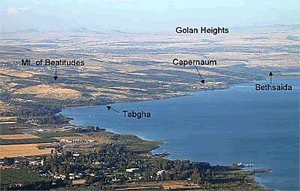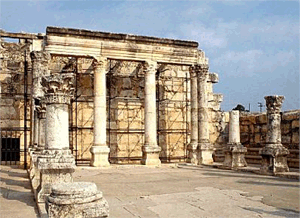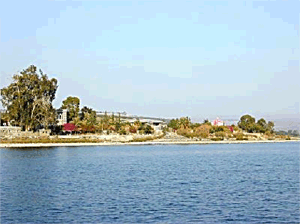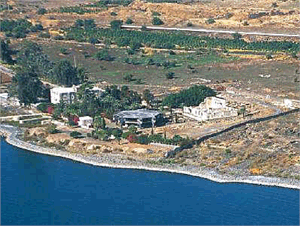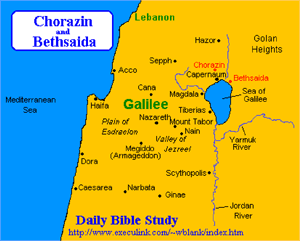
Christmas
Easter
Pentcoest
All Saints
Christ The King
Confirmation
Palm/Passion
Reformation
Stewardship
Books of the Bible
Lenten Series
Christmas Dramas
Videos
Series A - Matthew
Series B - Mark
Series C - Luke
Series D - Other
To contact
Edward F. Markquart
info@sfs.com
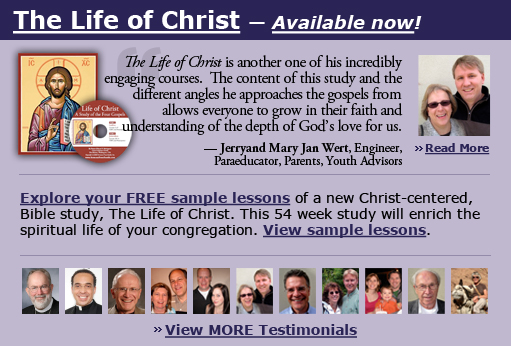
Series B PENTECOST 9B John 6:24-35 The following Bible study is from a larger course entitled, THE LIFE OF CHRIST: A Study in the Four Gospels. This 54 week course for the laity will be available for congregations in 2006. Basic text for the course: SYNOPSIS OF THE FOUR GOSPELS, Kurt Aland, English Edition, P. 139. Introductory Comments In the lectionary for Series B, there are five consecutive gospel lessons from John 6. A pastor could preach five consecutive sermons based on John 6. All of these Sundays share a similar theme about Jesus, the Bread of Life, today and forever. The sermon series from John 6 could be as follows: Pentecost 8 Jesus, A Sign: Feeding of the Five Thousand Pentecost 9 Jesus, Bread of Life Pentecost 10 Jesus, Eternal Life Pentecost 11 Jesus, Holy Communion/Eucharist Pentecost 12 Jesus, Hard Sayings/Teachings of Jesus Each of the above sermons has a distinct focus. A sermon needs a distinct focus, a central theme, even sermons from the Gospel of John which often has numerous ideas in one text. Helmut Thielicke, in his book, The Trouble With The Church, talked about the “textual-thematic” sermon. He suggested that sermon needs to be rooted in the text, but yet a preacher tries to find a central theme that will carry the sermon. Also, a central theme helps members of the congregation carry the sermon home with them. Other scholars have said that a sermon needs to have “the restraint of a single idea,” “the central kernel that saves the preacher/listener from getting lost in its details,” and “a thrust that can be expressed in one clear sentence.” The problem with preaching on a text from the Gospel of John is often there is no one, clear, central idea in a given text. It is often difficult to preach on John 6 because there so many themes in a given pericope. For example, on Pentecost 10, there are several themes that could be a focus for preaching: “I am the Bread of Life who lives forever,” “No one comes to the Father unless drawn him,” “No one has seen the Father except the Son,” “Whomever believes has eternal life,” “Whoever eats of this bread will live forever,” “The bread that I give is my flesh.” There are so many different themes for Pentecost 10 that a sermon can easily lose its primary focus. Both the preacher and listener can get lost in the details. I am suggesting five different sermons with five different controlling, central themes from John 6: Pentecost 8 Signs Pentecost 9 Bread of Life Pentecost 10 Eternal Life Pentecost 11 Holy Communion (Body, flesh, blood, real presence) Pentecost 12 Difficult Teachings Also, going in a different direction, we recall that both the gospels of Mark and John were written by eyewitnesses and both have a ring of historical authenticity to them. In the lectionary, Series B, during the Pentecost season, we are studying both of these authors. They both have juicy, historical tidbits of authenticity. In Series B, the Pentecost season, twenty gospel lessons are from the Gospel of Mark; five are from the Gospel of John. Both are eyewitnesses. The gospels of Mark and John seem to offer us the best historical recreations of the life of Jesus. The Gospel of John offers us many precise details in his accounts of Jesus’ life (five porticos near the pool, a lad had five loaves and two fish, fifty-three fish being caught in a resurrection story, etc.). John’s precise details do not feel like an author who is cleverly trying to create a perception of journalistic authenticity. At the same time John offers us all these nice juicy details, he is also highly philosophical. He believes from the beginning of his gospel that Jesus is the Son of God, and colors all of Jesus’ activities with full-blown divinity. A consequence of this is that the humanness of Jesus’ life is diminished in John’s gospel. By contrast, there is a earthy humanness to Mark’s gospel, and this earthy humanness is not in John’s gospel. Many scholars conclude that Mark was a remembrance about Jesus as told by Simon Peter to John Mark before Simon Peter died in Rome in about 65 CE. Perhaps the divinity of John’s gospel and the humanity of Mark’s gospel reflect the personalities of their different sources (John and Peter). It could also reflect Peter and John wrote many years after the life of Jesus—Peter, about thirty five years later and John, about sixty years later. This discourse about the bread of life is connected with Jesus’ feeding of the five thousand. The event of “walking on the water” is set between the feeding of the five thousand and the discourse on Jesus, the Bread of Life. It seems that the event about walking on water/calming the winds is not as important in the Gospel of John as the feeding of the five thousand. The feeding of the five thousand was called a sign; the event of “walking on water” was not. In the Gospel of John, Jesus delivers a long discourse about the Bread of Life. There is not a similar discourse following Jesus’ “walking on the water.” We recall similar, lengthy, philosophical discourses by Jesus. These discourses are not like parables, nor like short pithy teachings, nor like narratives about his life (e.g. the Mary and Martha story), nor are they like the miracles in the first three gospels. These discourses are longer, philosophical speeches by Jesus about his self-identity and his relationship to God, the Father. These discourses are similar to each other in their theological complexity and sophistication. Earlier In the Gospel of John, there have been three previous discourses e.g. with Nicodemus who needed to be born again, the woman at the well who needed to drink the living water, and the crippled man for thirty-eight years near the pool who needed to believe in the Son and be given eternal life. This is the fourth discourse in John’s gospel. It is as if we receive a fourth sign in the Gospel of John that is followed by a fourth philosophical discourse about the deeper significance of that sign. This discourse occurred at the synagogue in Capernaum, according to John 6:59, the last verse in the chapter. We recall the basic photograph which shows us the location of the village of Capernaum at the north end of the Sea of Galilee. Memorize the location of Tabgha (scene of the feeding of the five thousand) and Capernaum (scene of the discourse about the bread of life) in your mind. http://www.christiananswers.net/bibleplaces/home.html We recall other photographs of Capernaum that we studied earlier in Lesson 6 of this course on THE LIFE OF CHRIST. We recall that the photograph below is a reconstruction of the synagogue at Capernaum. The location of the synagogue has not changed. This was THE location of the synagogue in Capernaum in Jesus’ day. The rocks in the flooring of this reconstructed synagogue are very old and from the time of Jesus. The reconstruction is a good representation of a synagogue from Jesus’ day.
We recall that other events occurred at this synagogue: Jesus was confronted by a demoniac while teaching here (Mark 1:21-27). Jesus healed the centurion's servant, the centurion who built the synagogue (Luke 7:3). In this synagogue, Jesus gave his sermon/teaching on the bread of life (John 6:35-59). Sometimes, a Biblical scholar wonders if the synagogue that Jesus was thrown out of was not at Nazareth as the Gospel of Luke explicitly and uniquely tells us, but was the synagogue in his “own country” (Capernaum) as the Gospel of Mark tells us. The Gospel of John tells us that the teachings of John 6 occurred at the synagogue in Capernaum. John 6:59: “He said these things while he was teaching in the synagogue at Capernaum.”
Jesus made Capernaum his home during the years of his ministry: "Leaving Nazareth he went and lived in Capernaum" (Matt 4:13). Peter, Andrew, James and John were fishermen living in the village. Matthew the tax collector also dwelt here. Capernaum is one of the three cities cursed by Jesus for its lack of faith.
Capernaum was in existence from the second century BCE. to the seventh century CE. Capernaum was built along the edge of the Sea of Galilee and had up to 1500 residents. #148. Tiberias -The next day the crowd that had stayed on the other side of the sea saw that there had been only one boat there. They also saw that Jesus had not got into the boat with his disciples, but that his disciples had gone away alone. So often in the Gospel of John, the words feel as if an eyewitness wrote them. That is true of these words and detailed descriptions of what had happened in this particular episode. John reports that the crowd had seen only one boat and that Jesus had not gotten into it. John also reports that the disciples had gone away alone, without having Jesus in their boat. John and John’s gospel are persistently giving us little juicy historical vignettes. (This is also true of Peter and his gospel called the Gospel of Mark.) -Then some boats from Tiberias came near the place where they had eaten the bread after the Lord had given thanks. These people were from the city of Tiberias and they sailed/rowed to the remote place where Jesus fed the 5,000 (Tabgha). These words feel like a first-hand description by an eyewitness. In the author’s mind, there was a very specific geographic location of the feeding of the five thousand. There were groups of people who were in their boats and were looking for Jesus on the Sea of Tiberias/Lake Galilee. See the map below which locates the capital city of Tiberias. Remember that Tiberias was built in the year 18 CE and soon after, the Sea of Galilee then began to be called the Sea of Tiberias. The Gospel of John calls the Sea of Galilee the Sea of Tiberias. http://www.execulink.com/~wblank/20020117.htm
Notice how the words, “after the Lord had given thanks,” are unobtrusively inserted. It feels as if it is an accurate historical memory. “Giving thanks” is the English word for the Greek word, “Eucharist.”
The gospel lesson for Pentecost 9B, John 6:24-35, begins here. Preaching theme: The Bread of Life -So when the crowd saw that neither Jesus nor his disciples were there, they themselves got into the boats and went to Capernaum looking for Jesus. In the text, where is “there?” The crowds didn’t find Jesus nor the disciples THERE. The people looking for Jesus did not find him in the remote area of the feeding of the 5000 (Tabgha), so they got into their boats and sailed/rowed off to Capernaum which was about three miles up the lake from Tabgha. That was the scene of the "walking on the water" event. -When they found him on the other side of the sea, they said to him, "Rabbi, when did you come here?" They found Jesus. Respectfully, they called him “rabbi” but they did not call him by his true identity. Unwittingly, they asked him an important question, “Where did you come from?” This pattern often occurs in the Gospel of John. People ask an important question but don’t realize it. One of the most significant questions of the gospels is “Where do you come from, Jesus?” Of course, the right answer is “from God.” But these people did not know the right answer nor the importance of their question. John’s gospel uses this literary technique often, whereby people ask a profound question, with apparent innocence and naiveté. -Jesus answered them, "Very truly, I tell you, you are looking for me, not because you saw signs, but because you ate your fill of the loaves. Aha. Here is the problem. The crowds were seeking their fill of the loaves of bread. They wanted Jesus to become their “bread king,” so that Jesus would be their everlasting bakery to feed their expanding tummies and forever fill their bulging bellies. These people witnessed an improbable feat when Jesus fed 5,000 people but they did not see a sign from God. - Do not work for the food that perishes, but for the food that endures for eternal life, People knew human nature, and human nature is to work very hard to put food onto the table and pay all the bills that make for our survival. We all know about the symbolic statement of “gotta put the food on the table” which means to pay all bills in order to survive. That is still a problem today. People work so hard to get ahead financially and materially that we human being often slip into thinking that food and prosperity are the primary sources of our happiness. We human beings slowly discover the truth that genuine happiness is not found in money and material goods. As human beings, we work so hard for the things of this world which quickly run down, break down, rust, and rot, crumble and corrode. Everything does. It is truly amazing how fast food spoils and rots when it is not refrigerated or dried. Here is another fundamental teaching of Jesus: We are to hunger and thirst for the food that nourishes eternal life. Jesus gives us such food. Soon, in John 6, we will see that Jesus will give us his body and blood which are spiritual foods for eternal life. He also gives to us his living Word, the Bible, and his living water, the Spirit. We human beings are rightly deeply concerned about eating the right foods that nourish healthy physical bodies. We human beings are to be even more concerned about eating the right foods that nourish our spiritual bodies for eternal life. Living in a fast food world, we know how easy it is to become addicted to junk foods which are essentially unhealthy for our bodies. We also know it is easy to become addicted to junk spiritual food which is unhealthy for our souls. Circle the words, “eternal life.” Those words, “eternal life,” occur 16 times in the Gospel of John, six times within this one chapter of John 6, and another six times in I John. “Eternal life” is a central concept of John. In the planning of the series of five sermons from the Gospel of John, we will focus on the theme of eternal life in next Sunday's text and sermon. It is important that we emotionally and deeply grasp what “eternal life” means. This is primary gift that God wants to give to you and me. -which the Son of Man will give you. Notice that phrase, “the Son of man,” which is Jesus’ self title. Jesus always uses this phrase in the third person (except once), sounding like he is referring to another, but he is consistently referring to himself. In this passage and others, Jesus will consistently refer to himself as having the authority to give eternal life. Variations on that thought are:” You shall not taste death,” “You shall live forever,” and “You shall be raised on the last day.” Underline the phrase, “gives eternal life to you.” That is what Jesus wants to give to you and me: eternal life. Circle the word, “you.” Write in your name. Jesus’ gift of eternal life is personalized. That is, it was/is given to you and for you. And me. But not just for you and me personally. Eternal life is given to the world, to billions upon billions of people around us from all time and history and into all time and history. -For it is on him that God the Father has set his seal." (of authenticity or truth.) God has given his seal of approval to his Son, Jesus, who is the Son of man. In John’s gospel, this section seems to be a transition to the Bread of Life Discourse which follows. #149. The Bread of Life -Then they said to him, The “they” is the crowd. We persistently discover that the crowds are interested in Jesus primarily because they want a healing king (to free them from their diseases) or a bread king (to free them from their hunger and poverty) and or political king (to free them from their political oppression) but rarely does the crowd want Jesus himself to be their king, to ruler of their day-to-day lives and the lives of their family, community or nation. -"What must we do to perform the works of God?" The crowds often ask, “What do we need to do to do the works of God?” What does God want from us? -Jesus answered them, "This is the work of God, that you believe in him whom he has sent." As students of the Bible, we think that the “work of God” is to be doing works of love. Instead, we are somewhat surprised that the work that God wants from us is to believe in Christ. We recall from earlier lessons that the word, “believe,” means: TOKY. TOKY is an acronym which means “trust,” “obey” (the one commandment of love), “know” and say “yes” to Christ. The work of God is to believe in Christ. That is what God wants done in our lives: to believe in Jesus. We recall that the word, “believe,” and its variations occurs more than 425 times in the New Testament, whereas “born again” occurs four times. We are to be born again. Jesus wants us to be born again. To be born again is to believe in Christ. In the Gospel of John, there are twelve verses that specifically invite us to “believe in” Christ. Circle the word, “you.” What the Lord God wants from you and me is to believe. Write in your own name by the word, “you.” In the Gospel of John, Jesus is persistently the one whom God has sent into the world. -So they said to him, "What sign are you going to give us then, so that we may see it and believe you? What work are you performing? The crowds wanted to see another sign, another miracle, another spectacular demonstration of supernatural powers. The logic in the crowd was that if they saw a spectacular scene, they would then believe. For them, a fabulous sensation would create faith in them. The crowd did not “get it” that faith was in a person before a sign occurred. The sign was a consequence of faith, not a cause of faith. -Our ancestors ate the manna in the wilderness; as it is written, "He gave them bread from heaven to eat.' " The crowd thought that it was Moses who gave the people bread from heaven (manna) to eat, that it was Moses who had the powers within him, that Moses was the great figure who dominated Jewish history and was the source of manna in the wilderness. For the crowd, they thought the power of God rested in Moses rather than in God’s continuing presence with them. -Then Jesus said to them, "Very truly, I tell you, it was not Moses who gave you the bread from heaven, Jesus said that the crowds had the wrong focus. The focus was not to be on the powers of Moses but on the powers of God who creates wonders and signs and gives the true bread from heaven. The phrase, “bread comes down from heaven,” is repeated seven times in John 6. The phrase, “come down from heaven,” is almost always associated with "bread." Joh 6:33 - For the bread of God is that which comes down from heaven and gives life to the world." Joh 6:38 -for I have come down from heaven, not to do my own will, but the will of him who sent me. Joh 6:41 -Then the Jews began to complain about him because he said, "I am the bread that came down from heaven." Joh 6:42 -They were saying, "Is not this Jesus, the son of Joseph, whose father and mother we know? How can he now say, "I have come down from heaven'?" Joh 6:50 -This is the bread that comes down from heaven, so that one may eat of it and not die. Joh 6:51 -I am the living bread that came down from heaven. Whoever eats of this bread will live forever; and the bread that I will give for the life of the world is my flesh." Joh 6:58 -This is the bread that came down from heaven, not like that which your ancestors ate, and they died. But the one who eats this bread will live forever." In other words, Jesus as the “bread who has come down from heaven” is a dominant concept in the Gospel of John. -but it is my Father who gives you the true bread from heaven. Underline the little word, MY. Jesus got into trouble with the Jewish authorities when he inserted that little word, “my.” The Jewish leaders would have accepted his teaching if Jesus would have used the word, “our,” but he used the word, “my.” As we heard in one of Jesus’ earlier discourses, when Jesus referred to God as “my” Father, the leaders wanted to kill him for the blasphemy of making himself equal with God. Underline the little word, TRUE. Jesus himself is the true bread from heaven. The crowds want “false” bread, bread that feeds the stomach but not the soul/spirit. The crowds seem to have this quality of wanting FALSE bread that will momentarily satisfy their souls. It is still true today that people want FALSE bread to attempt to satisfy the inner hungers of our lives. It was and still is God the Father who gives us the true bread of life from heaven. -For the bread of God is that which comes down from heaven and gives life to the world." When the Jewish leaders heard Jesus’ words, they would have immediately thought of the manna that came down from heaven when the Israelites were in the Sinai wilderness with Moses. Jesus, of course, was thinking of himself as having come down from heaven to earth. It is Jesus himself who gives life to the world. -They said to him, "Sir, give us this bread always." Like the woman at the well who asked for living water, so these people asked a similar question, “Jesus, give us this bread always.” We people nowadays are the same: Jesus, give us this bread that gives us life. As the crowds got free bread out in the wilderness when Jesus fed the five thousand, they want more this free, life giving bread from God. The people did NOT realize that Jesus was the bread, the bread of life, the manna from heaven. -Jesus said to them, "I am the bread of life. Whoever comes to me will never be hungry, and whoever believes in me will never be thirsty. The bread of life. This needs to be the focus on the sermon on this text. Jesus is the bread of life. Jesus is pure love and compassion for ALL people on this earth. Jesus is God’s love. Jesus is eternal love. When you eat Jesus, you take in God’s pure love and compassion for ALL people into your heart. When we eat bread that is fresh and good, it is so invigorating. And so it is when we consume the bread of life, Jesus and God’s infinite love for all people in the world. This bread is sooooo good, the best bread in the whole wide world. Infinite love for all people, for all kinds of people Infinite compassion. Infinite justice and peace. Jesus’ love is sooooo good. The bread of life is so good. The bread of life and energy of love needs to be living inside of all of us. How we love to eat bread and consume it, especially when it is fresh and warm! How we love to consume Christ and his spirit of love into our lives! As we absorb the spirit of Jesus Christ and his love, justice and compassion, these qualities live more fully in us.
A tendency is to get lost in the details of the text, all of which are true and helpful. But it is important for a preacher to know the “power of the restraint of a single idea” and the single idea in this text is “I am the bread of life.” Everything else in this text serves this fundamental theme. Jesus is the source of life, the source of eternal life, the source of the values of our daily lives, the pattern of love for our daily lives. The basic food staple of the world is bread and Jesus is the basic spiritual staple of the world. Jesus is never just bread. Jesus is always the bread OF LIFE. As we consume bread, it gives us nourishment and energy for our physical lives. As we consume Jesus into our lives, he is the nourishment and energy for our spiritual, emotional and moral lives. Underline the phrase, “I am the bread of life.” Here is the first of the great, I AM, sayings of Jesus. There are seven, I AM, (ego eimi) sayings in the Gospel of John e.g.
These were all references to God the Father in the Old Testament and now Jesus teaches that these are references to himself as well. Focus on the verb, “I am.” I AM, a “be” verb, was the name of God in the Old Testament and we translate that verb, Yahweh or Jehovah. We recall the story of the Lord speaking to Moses out of the burning bush at Mount Horeb and revealing the divine name to Moses. I AM which becomes translated “Yahweh.” When Jesus gave the discourse to the woman at the well, he was the living water. In this text, he is the living bread. As Christians, we are to consume Jesus into our hearts, minds and souls. As we do so, we shall not be spiritually hungry because our spiritual hunger will have been fed. As Christians, we are to drink Christ into our hearts, minds and souls. As we do so, we shall not be spiritually thirsty because our spiritual thirst will have been quenched. |
